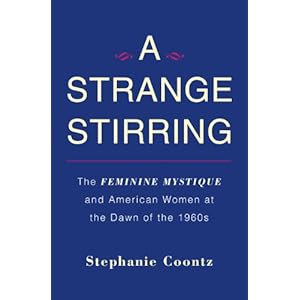 This is the fifth and final in a series this week from Girlw/Pen writers on Stephanie Coontz‘s new book, A Strange Stirring: The Feminine Mystique and American Women at the Dawn of the 1960s, which is a biography of Betty Friedan’s iconic book.
This is the fifth and final in a series this week from Girlw/Pen writers on Stephanie Coontz‘s new book, A Strange Stirring: The Feminine Mystique and American Women at the Dawn of the 1960s, which is a biography of Betty Friedan’s iconic book.
I’m obsessed, you could say, with second-wave feminism’s legacy. Questions like “How has feminism’s past shaped its future?” and “Why are battles begun 40 years ago so damn difficult, still, to win?” keep me up at night. So when I first heard that Stephanie Coontz—a pre-eminent social historian, and one tremendously adept at translating feminist research for popular audiences via the New York Times op-ed page no less—was writing a cultural history of The Feminine Mystique, I nearly peed in my pants.
Foremost on my mind was the question I hoped would be addressed: “What’s the relevance of The Feminine Mystique—book and concept—today?” Coontz’s book, A Strange Stirring: The Feminine Mystique and American Women at the Dawn of the 1960s, did not let me down. But I’m finding that in the wake of finishing it, I’m more than a little depressed.
As ever, the personal is political. And vise versa. I can’t help but read this social history through personal history—my own. Last week, after a year and a half of equally shared parenting with both of us working part-time from home, my paid hours were cut back and my husband Marco, who got an unexpected offer, went back to a full-time, on-site job. Overnight, I became Primary Parent, Emergency Contact, and Master Coordinator for our beloved 15-month old twins. I wrote—bitterly, I now confess—about the first day of the new arrangement at my other blog. The source of my knee-jerk bitterness? Though still a working woman, I feared being swallowed by the feminine mystique. Is this feminism unfinished, or undone?
The feminine mystique. I’m here to report that its ghost is alive and kicking in the psyches of a generation whose mothers knocked down doors so that we could walk through them. I won’t go so far as to say we’re haunted the way children of Holocaust survivors are (Betty Friedan wrote about the home as a “comfortable concentration camp”–she also, of course, and as Coontz expertly rehearses, wrote SO much more), but let’s just say that the term “feminine mystique” conjures up a vortex that women like me—highly educated, high-earning potential—dread.
Granted, to cut back momentarily (and temporarily) on paid work is not exactly the same as embracing the feminine mystique, but mentally it’s a slippery slope. I think back to Charlotte from Sex and the City at the very moment she quits her job at the art gallery to stay home: “I choose my choice! I choose my choice!” she doth protest–too much. That first shakey day at home, I spewed the opposite: “I didn’t sign up for this.”
After whining to my mother and counting my many blessings–battling the feminine mystique mirage in my head is a luxury compared to the real and punishing demons many single women with kids, for instance, face–I came to my senses and realized that not much in my life had changed from the one day to this next. Except that it had. Because I had this revelation: it only took one day as Primary Parent for me to realize how tenuous the so-called battle lines between “Stay-at-Homes” and “Working Moms” really are. At one point or another, we are each other. And the reason for our resentment-filled (and highly media-fueled, let’s face it) fighting, apparently, is that we are largely unsatisfied ourselves.
As Coontz notes in the final chapter (“Women, Men, Marriage, and Work Today: Is the Feminine Mystique Dead?”), a chapter in which I found myself underlining every other word, wives who work paid jobs and those who don’t say they’d like to switch roles (according to a study conducted 10 years ago that is). “In 2000 25% of the wives who worked full-time said they would prefer to be homemakers. On the other hand, 40 percent of all wives without paying jobs said they would rather be employed.” Those who work wish they could be working less—and that applies to men as well as women.
Why are so many men and women with families unhappy with their lot?
Because the job of feminism is far from done. Blinded, now, by the workforce ideal that “defines the ideal employee—male or female—as having no familial or caregiving obligations that compete with work” (some call it, as Coontz points out, the “career mystique”), our culture replaced one mystique with the next. And no one, so far, has had the power to take this new mystique down.
The moment for Career Mystique warriors has come. They are out there already, rattling our collective cage. Conversations at places like Role/Reboot and Daddy Dialectic and The Council on Contemporary Families and work+life fit and Viva la Feminista and Pundit Mom and The Motherlode lead us in the charge. And in the meantime, books like The Feminine Mystique remain relevant—all the more so—because their missions remain incomplete.
*Title inspired by the last line of Lisa Belkin’s recent post, “New Fears of Flying” over at The Motherlode.


 Are Dads Facing Discrimination at the Playground?
Are Dads Facing Discrimination at the Playground?


